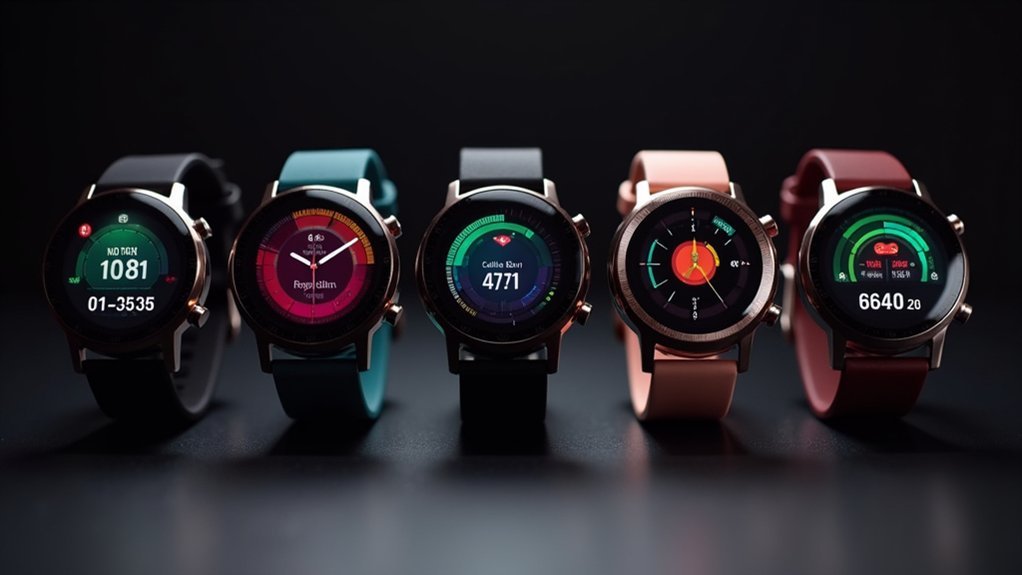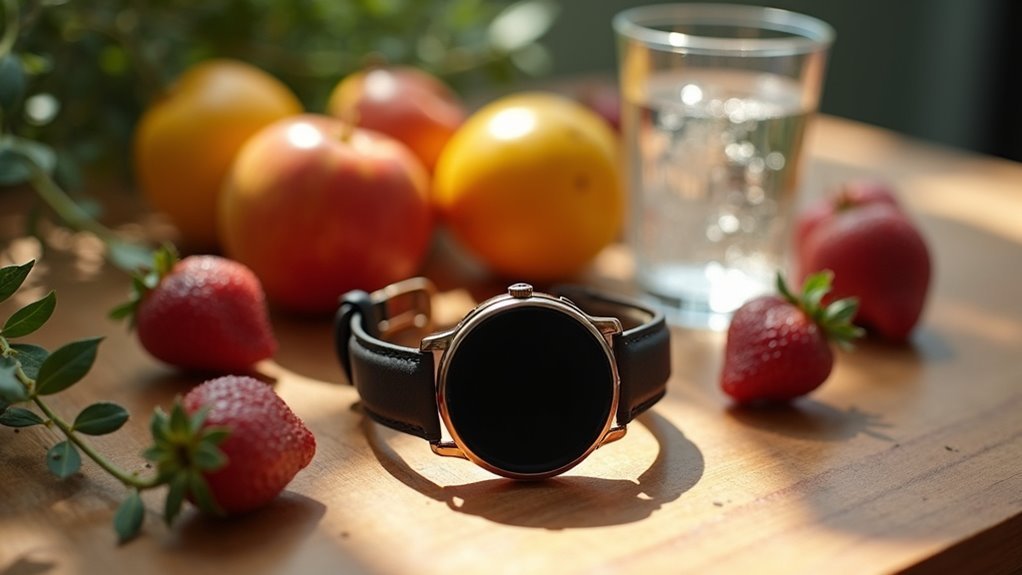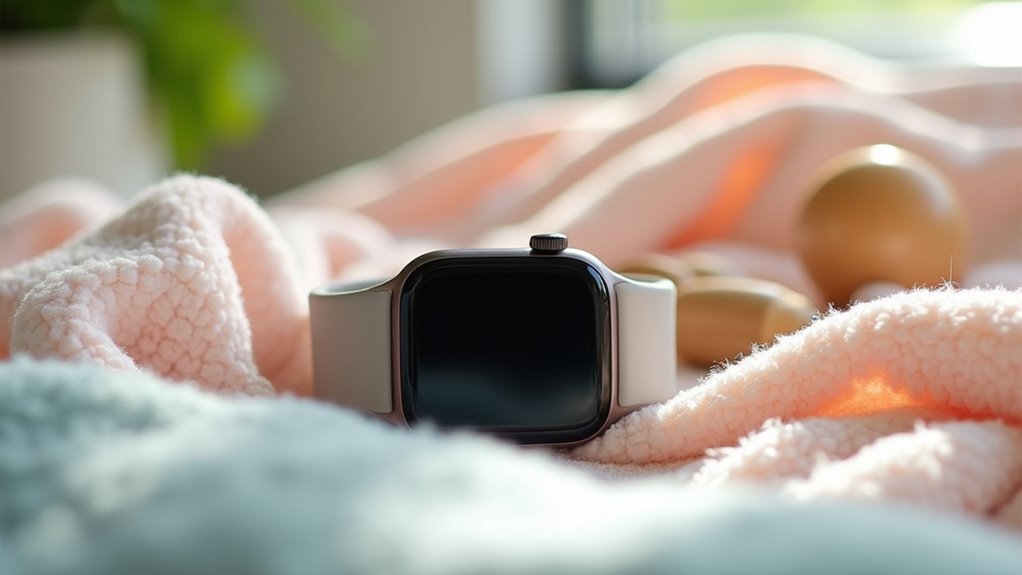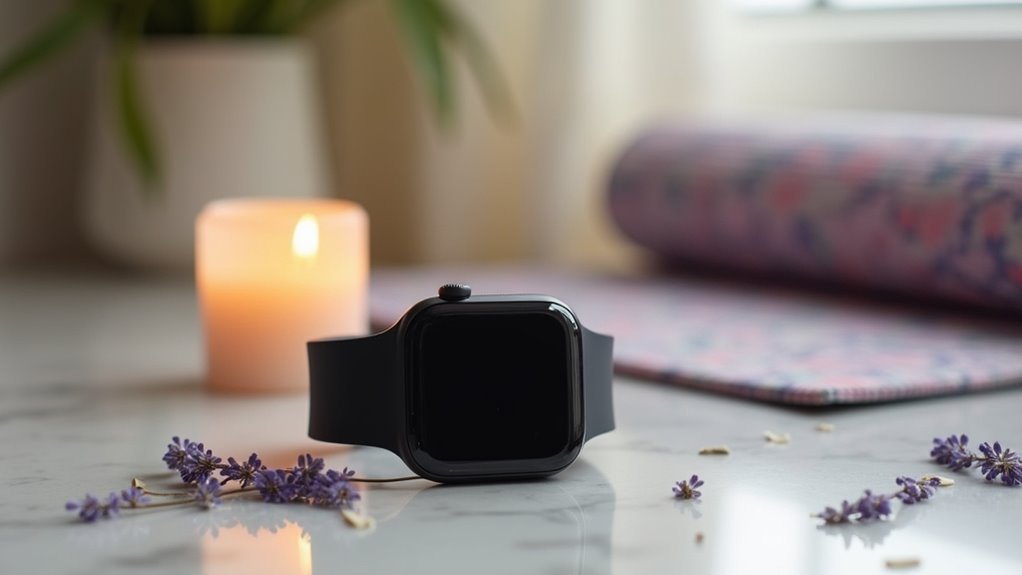You’ll find the Garmin Forerunner 955 Solar leads calorie tracking precision with superior VO2 max integration, achieving the highest accuracy during running activities. Apple Watch follows closely with advanced sensor fusion technology, maintaining 6-10% error rates across various workouts. Amazfit smartwatches offer balanced accuracy with exceptional battery life, while Fitbit Charge 5 provides extensive features but shows activity-specific biases of 25-61%. Sensor placement greatly impacts results, with wrist-based devices showing 40-80% error rates compared to more accurate alternatives that reveal optimization strategies.
Garmin Forerunner 955 Solar: Superior VO2 Max Integration for Precise Energy Expenditure
While many smartwatches rely on basic heart rate monitoring for calorie tracking, the Garmin Forerunner 955 Solar elevates energy expenditure accuracy through its sophisticated VO2 max integration.
You’ll experience more precise calorie calculations because the watch combines your personal data—age, weight, height, and gender—with real-time heart rate and speed metrics during activities.
The VO2 max integration provides a significant advantage over devices using heart rate data alone. You’ll find the accuracy particularly notable during running activities, where users consistently report satisfaction with calorie burn estimates.
VO2 max integration delivers superior calorie accuracy compared to heart rate-only devices, especially for running activities.
However, you must maintain proper watch fit and keep your personal data updated for best results. Remember that these devices provide ballpark estimates rather than laboratory-precise measurements for your daily energy expenditure tracking.
Studies show the Forerunner 955 delivers comparable calorie estimates to competing devices like the Apple Watch Ultra, making it a reliable choice for serious fitness tracking.
Apple Watch: Advanced Heart Rate Algorithms With Comprehensive Health Metrics
The Apple Watch distinguishes itself through sophisticated sensor fusion technology that combines optical heart rate sensors with accelerometers, gyroscopes, GPS, and elevation data to deliver clinically accurate fitness tracking.
You’ll benefit from machine learning algorithms that classify your activity type and intensity, enhancing calorie burn estimation precision. The device achieves mean absolute percentage errors ranging from 6.33% to 10.69%, with highest accuracy during peak exercise intensity.
Your calorie estimates incorporate real-time heart rate data with modeled activity classification for superior energy expenditure calculation. The watch uses your personal information including height, weight, gender, and age to calculate calorie burn with greater accuracy.
The watch intelligently prioritizes accuracy over continuous availability, withholding measurements when sensor quality is insufficient.
You’ll also access extensive health features including atrial fibrillation detection, irregular rhythm notifications, and ECG waveform generation for physician review.
Amazfit Smartwatches: Balanced Accuracy With Extended Battery Performance
Amazfit smartwatches deliver a compelling middle ground between fitness tracking precision and exceptional battery longevity that sets them apart in the crowded wearables market.
You’ll find their calorie burn tracking offers variable accuracy that depends heavily on your activity type and how well you’ve fitted the strap. While they mightn’t match Fitbit’s precision, you’re getting reliable heart rate monitoring and built-in GPS that enhances overall tracking performance.
The Amazfit Bip 5 demonstrates superior step tracking accuracy, staying within six steps of actual counts during testing. What truly distinguishes Amazfit is their remarkable battery life—you can expect up to 20 days on a single charge, making them ideal for travel and reducing charging hassles.
This extended performance, combined with robust build quality, water resistance, and competitive pricing, makes Amazfit watches excellent value propositions for users prioritizing convenience alongside decent fitness metrics.
Fitbit Charge 5: Feature-Rich Tracking With Calibration Considerations
Though Fitbit has improved its calorie burn calculations in the Charge 5 compared to older models, you’ll encounter mixed accuracy that varies considerably depending on your workout type.
The device shows moderate overall accuracy with a 0.64 correlation to actual calorie burn, but you’ll face significant activity-specific biases.
Here’s what you can expect:
- Walking and jogging: Overestimated by 25-61%
- Cycling: Underestimated by 37-59%
- Weight training: Overestimated by 12-48%
- Swimming: Less reliable due to sensor limitations
You’ll find the Charge 5 tracks relative daily trends accurately, showing which days you burned more calories.
However, absolute counts can differ by around 30%. Since the algorithm relies on basic metrics like weight and age without considering muscle mass, you’ll need to interpret calorie data cautiously. Users frequently report experiencing calorie burn discrepancies when engaging in high-intensity activities throughout their day.
Sensor Technology Impact on Cross-Device Calorie Measurement Variations
Five major sensor-related factors create considerable calorie measurement variations between smartwatch brands, making direct comparisons nearly impossible.
You’ll find wrist-based sensors struggle with movement artifacts and skin contact issues, recording 40–80% error rates compared to leg-mounted sensors’ 13% error. Different manufacturers use varying algorithm approaches—Samsung devices show 9.1–20.8% energy expenditure errors, while Apple Watch and Fitbit perform better for steps but still struggle with calorie precision.
Your individual characteristics considerably impact accuracy. Age, weight, skin tone, and wrist anatomy influence sensor performance, while device snugness can shift readings by 10–30%. Battery performance affects tracking consistency, with some devices maintaining accuracy for up to 28 days while others decline after just 7 days of use.
Motion artifacts during high-intensity exercise worsen tracking errors, and environmental factors like temperature affect sensor contact quality, creating inconsistent cross-device measurements.
Frequently Asked Questions
How Often Should I Update My Personal Data for Accurate Calorie Tracking?
You should update your weight whenever there’s a significant change of more than five pounds. Your age updates automatically annually, while gender and maximum heart rate need occasional adjustments based on fitness changes.
Can Smartwatches Accurately Track Calories During Strength Training and Weightlifting Sessions?
Smartwatches struggle with strength training calorie tracking due to limited movement sensors and static exercises. You’ll see significant inaccuracies compared to cardio workouts, as accelerometers can’t capture lifting intensity effectively.
Do Expensive Smartwatches Always Provide Better Calorie Burn Tracking Than Budget Options?
You won’t necessarily get better calorie tracking from expensive smartwatches. Studies show high-end Apple Watches and Garmins often have similar error rates to budget devices, since accuracy depends more on algorithms than price.
Which Smartwatch Works Best for Tracking Calories During Swimming and Water Activities?
You’ll get the best swimming calorie tracking with Garmin Fenix 8 or Garmin Swim 2. They offer accurate stroke analysis, SWOLF measurements, and reliable heart rate monitoring that’s specifically designed for water activities.
How Do Environmental Factors Like Temperature and Altitude Affect Calorie Burn Accuracy?
Cold temperatures increase your metabolism while heat raises your heart rate, skewing smartwatch calculations. High altitudes boost oxygen consumption and affect sensors. You’ll get ~40% errors versus ~6% with thermal-integrated devices.





Leave a Reply